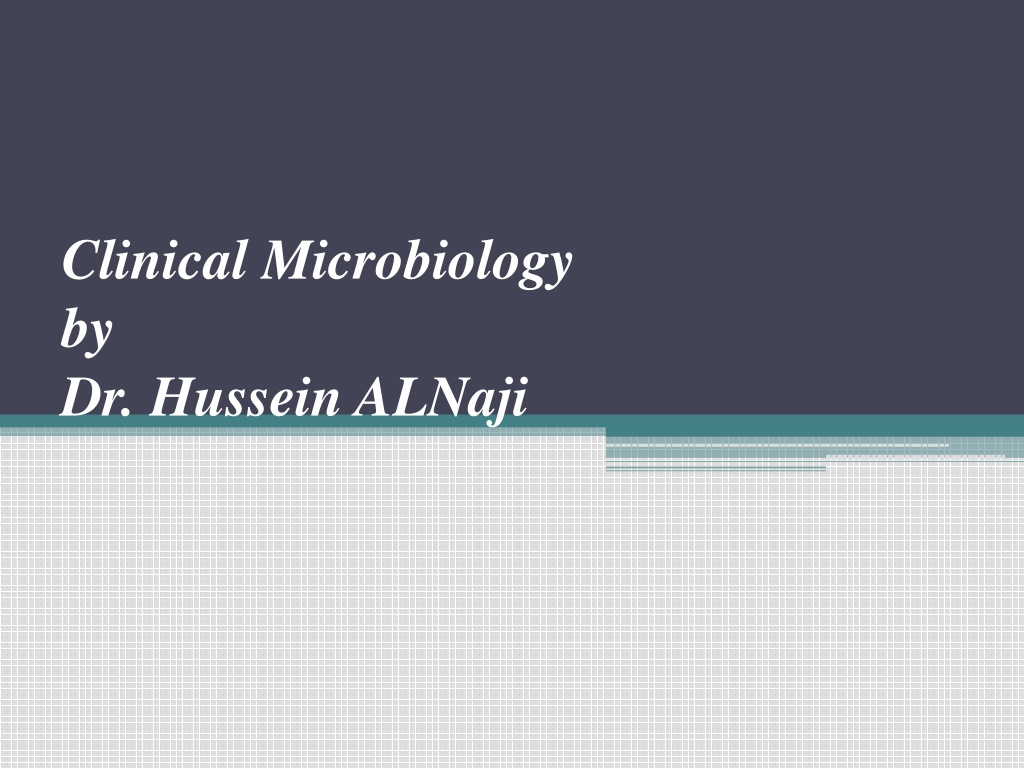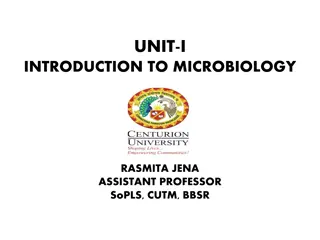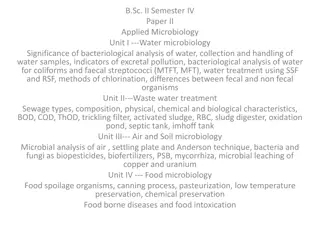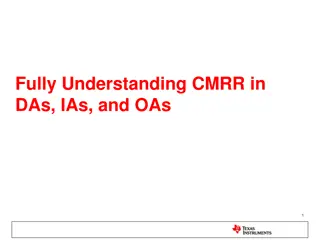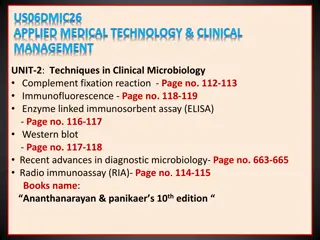Understanding Selective and Differential Media in Clinical Microbiology
Mannitol Salt Agar, MacConkey's Agar, Eosin Methylene Blue Agar, and Salmonella Shigella Agar are crucial tools in clinical microbiology for isolating and identifying specific bacteria. These selective and differential media help differentiate between different strains based on their ability to ferment certain substances, aiding in accurate diagnosis and treatment selections.
- Clinical Microbiology
- Selective Media
- Differential Media
- Bacterial Identification
- Pathogenic Bacteria
Uploaded on Sep 21, 2024 | 0 Views
Download Presentation

Please find below an Image/Link to download the presentation.
The content on the website is provided AS IS for your information and personal use only. It may not be sold, licensed, or shared on other websites without obtaining consent from the author. Download presentation by click this link. If you encounter any issues during the download, it is possible that the publisher has removed the file from their server.
E N D
Presentation Transcript
Clinical Microbiology by Dr. Hussein ALNaji
Mannitol Salt Agar (MSA): Mannitol salt agar is both a selective and differential media used for the isolation of pathogenic Staphylococci from mixed cultures. On MSA, only pathogenic Staphylococcus aureus produces small colonies surrounded by yellow zones. The reason for this color change is that S. aureus have the ability to ferment the mannitol, producing an acid, which, in turn, changes the indicator color from red to yellow. This growth differentiates S.aureus from S.epidermidis, which forms colonies with red zones or both zones.
MacConkeysAgar (MAC): MacConkey s Agar is both a selective and differential media; it is selective for Gram negative bacteria and can differentiate those bacteria that have the ability to ferment lactose. By utilizing the available lactose in the medium, Lac+ (Lactose positive) bacteria such as Escherichia coli, Enterobacter and Klebsiella will produce acid in the medium, results in the appearance of red or pink colonies. Non-lactose fermenting bacteria such as, Proteus species,Salmonella, Pseudomonas aeruginosa and Shigella cannot utilize lactose in the medium, and will use peptone instead. and leads to the formation of white or colorless colonies in the plate.
Eosin Methylene Blue (EMB) Agar (Levine): It is both a selective and differential medium used for the detection and isolation of Gram- intestinal pathogens. Acid production from lactose fermentation causes precipitation of the dyes on the surface of the colony resulting in different colors. Large amounts of acid green metallic sheen Small amounts of acid pink No fermentation colorless Enterobacter aerogenes produces large colonies which are pink-to-buff around dark centers. Escherichia coli produce small, dark colonies with a green metallic sheen. Pseudomonas, Proteus, Salmonella and Shigella sp produces colorless colonies because it does not ferment lactose.
Salmonella Shigella Agar (SS Agar). It is a selective and differential medium widely used in sanitary bacteriology to isolate Salmonella and Shigella from feces, urine, and fresh and canned foods. Inhibition of gram-positive microorganisms is obtained by the bile salts mixture. Lactose fermenter: If lactose fermentation occurs, the medium will turn red due to the acidic pH. E.g. Escherichia coli, Klebsiella pneumoniae gives red colonies. Non-Lactose fermenter: Salmonella, Shigella,and other non-lactose fermenters appear as transparent or translucent colorless colonies. Colonies of Salmonella spp. may appear with or without black centers (depending on the species isolated).
Biochemical reactions: microbiology laboratories typically will identify a pathogen in a clinical sample, purify the microorganism by plating a single colony of the microorganism on a separate plate, and then perform a series of biochemical studies that will identify the bacterial species. Coagulase test used to distinguish between Staphylococcus aureus from coagulase negative Staphylococcus spp.
Catalase test The catalse test is primarily used for gram positive bacteria and can for instance be utilized to distinguish Staphylococcus spp. and Micrococcus spp., which are catalase positive from Streptococcus spp. and Enterococcus spp. Citrate test used to distinguish between, among others Citrobacter freundii and Escherichia coli.
Indole test Confirmation of suspected E. coli-strains. Oxidase test The oxidase test is used for identification of gram negative bacteria. Urease test The urease test can be used to distinguish between E. coli, which is urease negative, from Proteus spp., which are urease positive. Voges-Proskauer (VP) test Klebsiella spp. and Enterobacter spp. has the capacity to perform butanediole fermentation in contrast to Escherichia coli, Salmonella spp. and Shigella spp.
